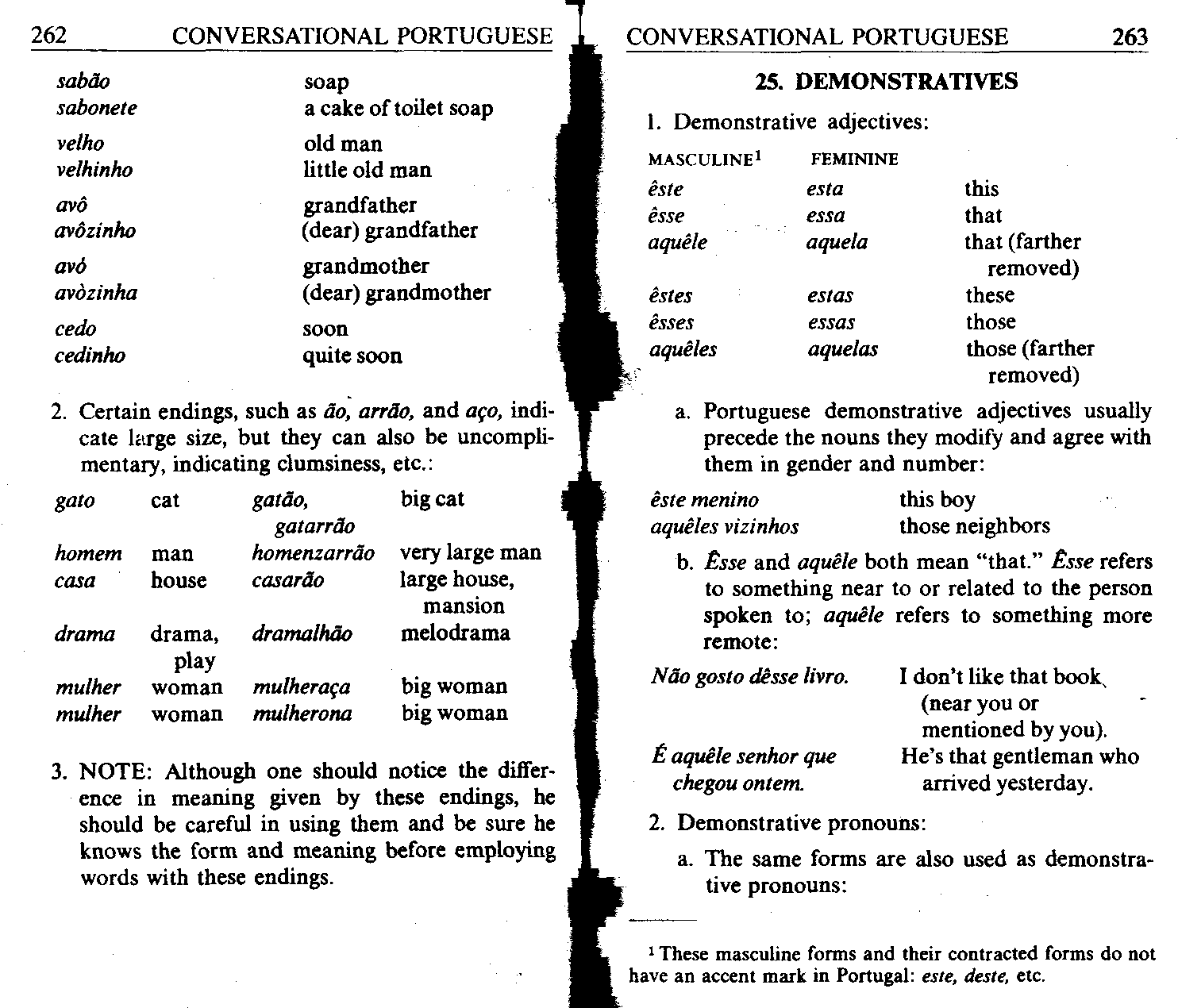Summary p262

262 CONYERSATIONAL PORTUGUESE
|
sabdo |
soap |
|
sabonete |
a cake of toilet soap |
|
velho |
oldman |
|
velhinho |
little old man |
|
avó |
grandfather |
|
avózinho |
(dear) grandfather |
|
avó |
grandmother |
|
avózinha |
(dear) grandmother |
|
cedo |
soon |
|
cedinho |
quite soon |
2. Certain endings, such as do, arrdo, and aęo, indi-cate large size, but tbey can also be uncompli-mentary, indicating clumsiness, etc.:
|
gato |
cat |
gatao, gatarrdo |
big cat |
|
homem |
man |
homenzarr&o |
very large man |
|
casa |
house |
casardo |
large house, mansion |
|
drama |
drama, play |
dramalhdo |
melodrama |
|
mulher |
woman |
mulheraęa |
big woman |
|
muiher |
woman |
muiherona |
big woman |
3. NOTĘ: Although one should notice the differ-ence in meaning given by these endings, he should be careful in using them and be surę he knows the form and meaning before employing words with these endings.
25. DEMONSTRATIVES
1. Demonstrative adjectives:
|
MASCULINE1 |
FEMININE | |
|
este |
esta |
this |
|
esse |
essa |
that |
|
aąuele |
aąuela |
that (farther removed) |
|
estes |
estas |
these |
|
esses |
essas |
those |
|
aąueles |
aąuelas |
those (farther |
removed)
a. Portuguese demonstrative adjectives usually precede the nouns they modify and agree with them in gender and number:
estemenino thisboy
aąueles vizinhos those neighbors
b. £sse and aąuele both mean “that.” źsse refers to something near to or related to the person spoken to; aąuele refers to something morę remote:
Nao gosto desse livro. I don’t like that books
(near you or mentioned by you).
£ aąuele senhor ąue He's that gentleman who
chegou ontem. arrived yesterday.
2. Demonstrative pronouns:
a. The same forms are also used as demonstra-tive pronouns:
These masculine forms and their contracted forms do not have an accent mark in Portugal: este, deste, etc.
Wyszukiwarka
Podobne podstrony:
Summary p222 222 CONYERSATIONAL PORTUGUESE 21. Vamos_(to have dinner). a. jantar
Summary p224 224 CONYERSATIONAL PORTUGUESE (3) variations occur in different areas: a.
Summary p226 226 CONYERSATIONAL PORTUGUESH CONYERSATIONAL PORTUGUESE 227 d g g h j I I Ut m as d i
Summary p230 230 CONYERSATIONAL PORTUGUESE 3, The cedilla (cedilha) is used with
Summary p234 234 CONYERSATIONAL PORTUGUESE k. with parts of the body and articles of clothing inst
Summary p236 236 CONYERSATIONAL PORTUGUESE De and em combine with the demonstrative forms (see GS2
Summary p238 238 CONYERSATIONAL PORTUGUESE 13. MASCULINE AND FEMININE 238 CONYERSATIONAL PORTUGUES
Summary p240 240 CONYERSATIONAL PORTUGUESE 14. THE PLURAL 1. Nouns ending in a vowel, including na
Summary p242 242 CONYERSATIONAL PORTUGUESE seu can also be used to translate “his,” “her,” “their.
Summary p246 246 CONYERSATIONAL PORTUGUESE 1«. COMPAR1SON 1. Rcgular comparison facil easy ma
Summary p248 248 CONYERSATIONAL PORTUGUESE 19. PRONOUNS Pronouns have varying forms depending on w
Summary p250 250 CONYERSATIONAL PORTUGUESE CONYERSATIONAL PORTUGUESE_ 251 (te) I
Summary p254 254 CONYERSATIONAL PORTUGUESE Nao me escreva mais. Eles decidiram que nos mandar
Summary p256 256 CONYERSATIONAL PORTUGUESE 21. SOME CONJUNCTIONS ainda que assim que ate
Summary p258 258 CONYERSATIONAL PORTUGUESE 23. ADYERBS 1. Some Portuguese adverbs are formed by ad
Summary p260 260 CONYERSATIONAL PORTUGUESE la (acold) there (morę remote) adiante . forward,
Summary p264 264 CONYERSATIONAL PORTUGUESE Ndo ąuero este sem I don’t want this one
Summary p266 266 CONYERSATIONAL PORTUGUESE27. NEGATION 1. Ndo “not” comes before
Summary p268 268 CONYERSATIONAL PORTUGUESE 2. The personal infinitiye has endings which make it ea
więcej podobnych podstron